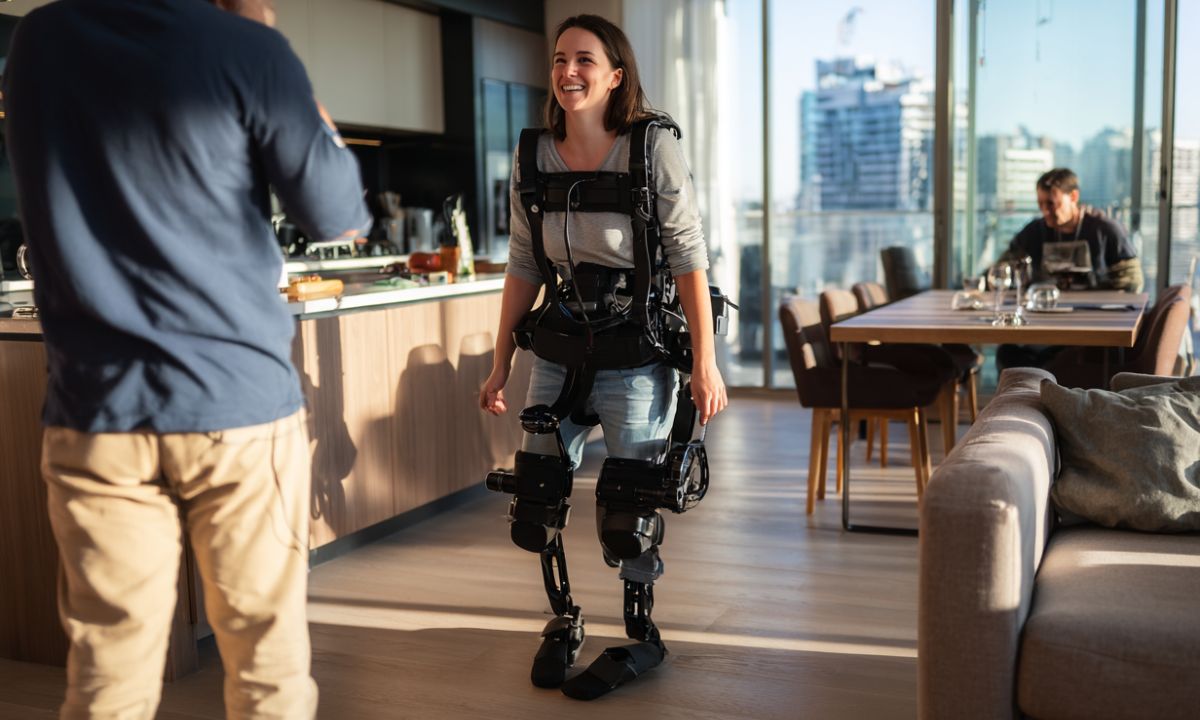The Digital Accessibility Revolution: How Technology is Empowering Australians with Disabilities

Approximately 5.5 million Australians have a disability, a figure that has risen significantly since 2018. For these Australians, the recent revolution in digital accessibility represents more than just convenience, it has opened up new pathways to independence and inclusion that were unimaginable just a few short years ago.
As the world becomes increasingly digital, there has been a rise in innovative technologies which break down barriers and create opportunities for people with disabilities. Whether it’s exoskeletons helping people walk again or policy changes enforcing digital inclusion, the future is bright.
Let's take a closer look at the latest cutting-edge innovations that are empowering Australians with disabilities, and examine how technology is becoming the great equaliser in today’s digital society.
The Current State of Digital Inclusion in Australia
There has been promising progress toward digital inclusion for disabled Australians. According to the Australian Digital Inclusion Index, the national digital inclusion score has steadily improved from 67.5 in 2020 to 73.2 in 2023, indicating that more and more Australians now have access to digital technologies and are developing the skills to use them effectively.
However, behind these encouraging numbers lies a sobering reality, which is that digital inclusion isn't evenly distributed. The Index reveals several persistent gaps that particularly affect:
- First Nations people in remote areas, who face a 21.6-23.5 point digital gap compared to non-First Nations Australians
- Older Australians, especially those over 75, who record digital ability scores 41.6 points below the national average
- Australians with disabilities, who often face multiple barriers to digital participation
- Rural and remote communities, where infrastructure limitations compound accessibility challenges
Perhaps most concerning of all are the 9% of Australians who remain highly digitally excluded, with Index scores of 45 or below. Although this is an improvement from 10.6% in 2021, it still means that almost one in ten Australians are effectively locked out of our increasingly digital society.
This is especially damaging for Australians with disabilities, who often rely on digital technologies to navigate daily life and maintain social connections.
Innovative Mobility Technologies
For Australians with impaired mobility, there have been an array of recent technological innovations which create new possibilities for independence and rehabilitation.
Exoskeleton Technology: Walking into the Future
Robotic exoskeletons are among the most transformative technologies emerging in Australia. These wearable robotic devices help people dealing with mobility impairments resulting from things like spinal cord injuries or stroke to stand and walk again.
In Sydney, Royal Rehab has pioneered the use of the EksoNR robotic exoskeleton to offer life-changing outcomes for patients that go far beyond just physical support. Users have reported improved mobility as well as huge psychological benefits from being able to stand upright and walk, sometimes for the first time since their injury.
And these positive results extend beyond the physical therapy environment. For many users, sessions with exoskeleton technology have led to improved confidence and independence. As these technologies become more refined and affordable, the scope for home use increases, which has the potential to revolutionise mobility for thousands of Australians suffering from permanent disabilities.
Vision Assistance Breakthroughs
Australians with visual impairments often struggle to deal with the unique challenges of physical and digital environments. Fortunately, there are now innovative technologies addressing these barriers in ways that transform daily independence.
The "Wearable Cane" Revolution
A standout innovation in this space is the Ara Assistive Technology Device by Strap Technologies. This "wearable cane" uses sophisticated sensors and haptic feedback to help visually impaired users navigate their surroundings confidently and safely, with early adopters reporting an 80% reduction in accidents caused by unnoticed obstacles.
This device works by scanning the environment and translating potential hazards into haptic signals that users can interpret. These wearable canes help people with visual impairments navigate crowded streets, unfamiliar environments, and public spaces with greater independence.
The ability to adapt to individual needs and preferences makes these technologies particularly valuable. Users can customise sensitivity levels, feedback intensity and detection ranges to suit their specific requirements and the environment they’re in.
As these technologies become more accessible and mainstream, they have the potential to significantly improve mobility and independence for Australians with visual impairments.
Also read: Adjusting to Life as a Carer for Someone with a Disability or Illness
Digital Communication Innovations
Traditional computer interfaces present several significant barriers for Australians with physical disabilities, but there has been a recent rise in innovative input devices that are helping solve these issues.
Beyond the Keyboard and Mouse
A great example is technologies like GlassOuse, head-controlled mouse alternatives which help people who have limited hand mobility to use computers. These devices translate head movements into cursor control, allowing those with conditions like quadriplegia, motor neurone disease and cerebral palsy to use computers, tablets and smartphones independently.
The impact of this extends far beyond convenience. For many Australians with physical disabilities, these tools offer users unprecedented opportunities, such as:
- Gaining employment, usually through remote work
- Pursuing educational or professional courses
- Staying connected with family and friends
- Accessing online shopping and entertainment services
- Participating in digital citizenship and advocacy
These groundbreaking technologies allow users to continue working remotely and maintain social connections even after losing hand function.
Australia's Digital Accessibility Policy Landscape
Despite these amazing advancements, technological innovation alone won't be enough to ensure digital inclusion for those who need it most. Australia's evolving policy landscape is playing a key role in creating an accessible digital environment for everyone.
The Digital Experience Policy: A New Standard
Australia is in the process of implementing several policy changes that will transform digital accessibility requirements. The Digital Experience Policy mandates that:
- By January 1, 2025, all new government websites must comply with enhanced accessibility standards
- By July 2025, existing government services must transition to meet these standards
This will ensure that the government’s digital services are accessible to all Australians, regardless of ability or impairment. From tax services to healthcare portals, these policies will create a consistent and accessible user experience across all government digital touchpoints.
The Disability Discrimination Act: Legal Protection
These specific policies are underpinned by the Disability Discrimination Act 1992 (DDA), which prohibits discrimination against people with disabilities in various areas of public life, including access to digital services. The DDA has been interpreted to include digital accessibility requirements, and there have been several high-profile legal cases reinforcing these obligations.
In 2014, a landmark case saw a visually impaired woman file a complaint against Coles supermarket because their online shopping service was inaccessible to her. The case reached the Federal Circuit Court and highlighted the legal consequences organisations can face if they have digital services that aren’t accessible to everyone.
These cases prove that digital accessibility is more than simply good business practice, it's a legal requirement.
Challenges and Future Directions
There has been significant progress in this domain, but there are several remaining challenges on Australia's journey toward comprehensive digital accessibility.
Persistent Barriers
While there has been improvement nationally, digital inclusion remains closely linked to factors like age, location, and socioeconomic status. The Digital Inclusion Index reveals that:
- The gap between younger and older Australians has grown slightly, especially in terms of Digital Ability
- People aged 65-74 record scores 12.1 points below the national average
- Those over 75 record score 24.6 points below the national average
- Areas outside capital cities score 5.0 points less than capital cities
This is of particular concern given that disability prevalence increases significantly with age, as Queensland Government statistics show:
- 15 to 24 years: 16.7% have a disability
- 65 to 69 years: 41.9% have a disability
- 90 and over: 81.1% have a disability
This results in a "double disadvantage" where those most likely to have disabilities are also the most likely to face challenges with digital ability.
Cost and Availability
A huge barrier for many Australians with disabilities is the price of these services. While the NDIS can provide funding for assistive technologies, not all Australians with disabilities qualify and there is a lengthy approval process.
The Australian Human Rights Commission has recommended several measures to address these challenges, including:
- A concessional broadband rate for people with disability
- Expanded NDIS funding for Digital Communication Technologies
- Improved education and training in digital accessibility
Digital Ability Gap
The biggest hurdle for digital accessibility is almost certainly the digital ability gap. This includes the skills, confidence and knowledge required to use digital technologies. This is a gap that disproportionately affects older Australians and those in regional areas with disabilities.
Solving this issue requires a detailed approach that goes beyond simply providing technology. For example, more educational programs, peer support networks and accessible training materials are all essential.
The Path Forward: Technology as an Equaliser
The potential for technology to help Australians with disabilities live happier, healthier and more fulfilled lives has never been greater. Emerging tools like artificial intelligence, voice recognition and augmented reality promise to further help and create new opportunities for inclusion.
The Australian Human Rights Commission has recommended applying a 'human rights by design' approach to digital technologies to help ensure that accessibility and inclusion are built into the foundation of new innovations rather than just added as afterthoughts.
This approach involves:
- Government adoption and promotion of good practices
- Incorporating accessibility principles into education and training
- Upskilling the existing workforce through professional development
- Implementing practical capacity building measures for accessible design
By combining technological innovation with thoughtful policy and education, Australia has the opportunity to create a truly inclusive digital society where technology empowers every Australian, regardless of ability, to participate fully in all aspects of life.
For Australians with disabilities seeking TPD claims, these technological advancements and accessibility improvements also make the claims process easier to navigate. The digital accessibility revolution means greater independence not just in daily life, but also in accessing important financial support when needed.
To enquire about TPD claims (Total and Permanent Disability insurance claims attached to your Superannuation fund), contact Smith's Lawyers online or call 1800 960 482. Our No Win, No Fee, No Catch® guarantee means that in the unlikely event your case goes to court and you're unsuccessful, we'll cover the costs and you won't pay a cent to us or anyone else.
In nearly 30 years, we've never had a single client out of pocket.
If it's time to talk, we're here to help. Get free advice direct from our solicitors today.





